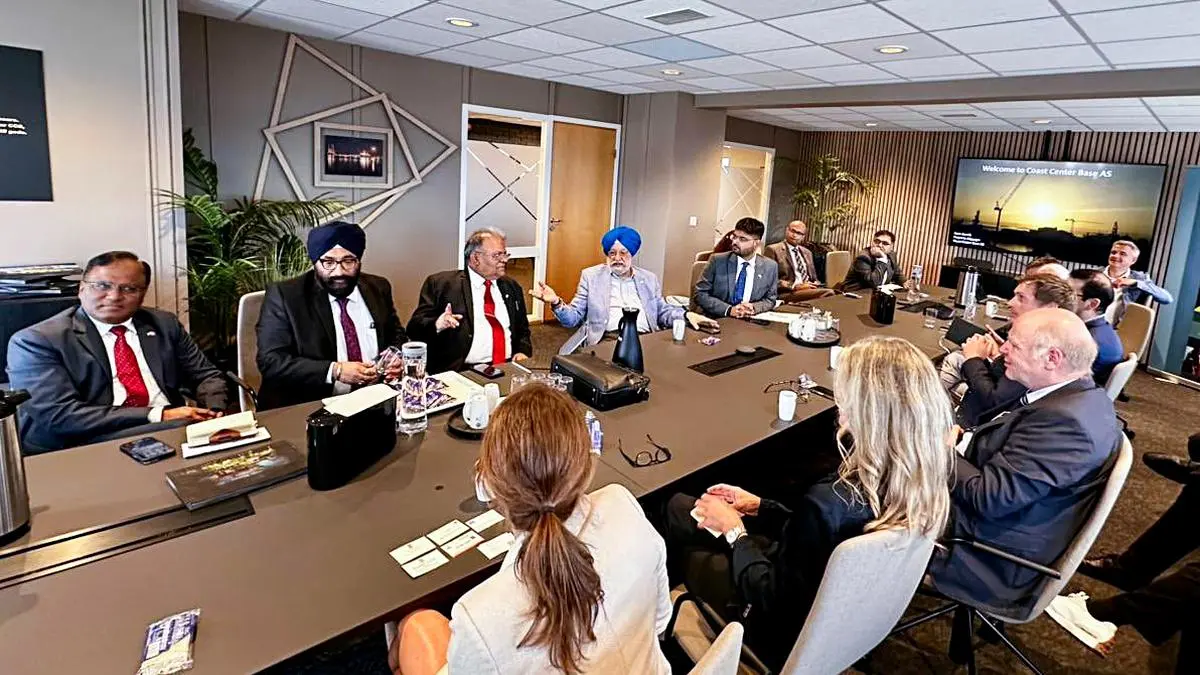
Union Minister of Petroleum and Natural Gas Hardeep Singh Puri during a roundtable with representatives of Offshore Energy Cluster, in Bergen on Monday.
| Photo Credit:
Hardeep Singh Puri – X
Oil Minister Hardeep Singh Puri, who is on an official trip to Norway, held a roundtable discussion with energy firms, including Equinor, on Monday as India aims to exploit its oil and gas resources in the deep waters.
As India plans to explore over 2.5 lakh sq kms in Open Acreage Licensing Policy (OALP) Round 10 in one of the largest offshore exploration bidding rounds globally, India is trying to develop a full exploration and production (E&P) deepwater technology ecosystem in India, he said on X late Monday evening.
“In a roundtable with representatives of Offshore Energy Cluster in Bergen, Norway we held invigorating discussions on technologies including well services, subsea operations, testing, maintenance operations, drilling tools, drilling submersible rigs, well completion services, high pressure high temperature wells, drillships, monitoring technologies covering the entire gamut of hydrocarbons exploration, particularly deep sea exploration by the Norwegian energy professionals,” he added.
Representatives from TechnipFMC, Reach Subsea, DNV Group, Odfjell Drilling, CCB Subsea, Shearwater, Innovasjon Norge, NORWEP, along with representatives from
Equinor India participated in the meeting, which was also attended by Jostein Dahl Karlsen, representing the Norwegian Foreign and Energy Ministries, the Minister stated
Focus on Blue Hydrogen and CCS
Puri also visited the CCB Energy Blue Hydrogen Plant, a first-of-its-kind commercial blue hydrogen facility located in Kollsnes as part of CCB Energy Park in Øygarden, Norway.
“It was interesting to see the world’s first commercial plant which produces blue hydrogen with integrated carbon capture and subsea storage,” he added.
This strategically positioned plant is a joint initiative between CCB Energy (a part of CCB Energy Holding and H2 Production) and ZEG Power, leveraging proprietary “ZEG-H₂” reforming technology with built-in CO₂ capture.
The captured carbon is transported to the adjacent Northern Lights facility for storage and processing. The pilot plant produces around 1 ton of hydrogen per day while capturing nearly all associated CO2, Puri explained.
Northern Lights CO2 terminal visit
The Minister also visited the Northern Lights CO2 Terminal in Bergen, which is the largest carbon storage project funded by the Norwegian government and partnered by Equinor, Shell, and Total Energies.
This unique project can store up to 100 million tonnes of carbon dioxide. It has an open and flexible infrastructure to transport CO2 from capture sites by ship to a receiving terminal in western Norway for intermediate storage, before being transported by pipeline for safe and permanent storage in a reservoir 110 kms away from shore & 2,600 metres under the seabed.
“We are reviewing this, and similar projects, to upgrade and expand India’s energy capabilities. Norway’s expertise in deepwater exploration, seismic oil surveys, offshore wind and carbon capture and storage (CCS) technologies aligns well with India’s ambitious energy transition agenda,” Puri said.
Published on July 8, 2025
